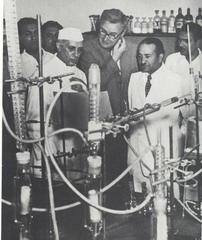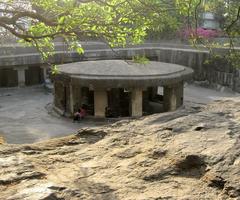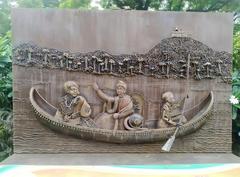Tilak Smarak Mandir Pune: Visiting Hours, Tickets, and Historical Significance
Date: 15/06/2025
Introduction: The Legacy of Tilak Smarak Mandir
Tilak Smarak Mandir, located in the heart of Pune, stands as a testament to the enduring legacy of Lokmanya Bal Gangadhar Tilak—one of India’s most influential freedom fighters and social reformers. Established in 1925, the Mandir is both a memorial and a vibrant cultural center. With its distinctive fan-shaped auditorium, adorned with murals by Gopal Deuskar, it not only commemorates Tilak’s life but also serves as a hub for cultural, educational, and civic activities. Its strategic location on Tilak Road in Sadashiv Peth, near other important landmarks like Shaniwar Wada and Aga Khan Palace, makes it a pivotal point on Pune’s heritage circuit (Wikipedia, Scribd, NRI News 24x7, RoamingVerse).
Table of Contents
- Introduction
- Historical Background
- Visiting Information
- Nearby Attractions
- Frequently Asked Questions (FAQs)
- Visuals and Media Recommendations
- Practical Tips for Visitors
- Conclusion and Further Resources
Historical Background
Origins and Dedication
Founded just five years after Tilak’s passing, Tilak Smarak Mandir was envisioned as a space to honor the memory and ideals of Lokmanya Tilak. It was constructed on land with deep historical roots, formerly belonging to the Pandit family, and later donated for the purpose of commemorating Tilak’s role in India’s independence movement (Wikipedia, Local Guides Connect).
Architectural Features and Murals
The Mandir’s design ingeniously combines early 20th-century architectural innovation with traditional Maharashtrian motifs. Its fan-shaped auditorium ensures optimal acoustics and sightlines, seating nearly 1,000 spectators across its main and balcony sections (Scribd). The building is distinguished by murals from Gopal Deuskar, depicting pivotal events from Tilak’s life—such as his leadership in the Swadeshi movement and the popularization of Ganesh Chaturthi and Shivaji Jayanti as platforms for mass mobilization (Wikipedia).
Cultural and Community Role
Since its inception, Tilak Smarak Mandir has played a central role in Pune’s cultural and civic life. The auditorium has hosted an array of events: from Marathi plays and classical music concerts to political debates and educational lectures. It is a favored venue for commemorating Tilak’s birth and death anniversaries and acts as a linchpin for the promotion of Marathi language and heritage (Scribd, NRI News 24x7).
Modern Upgrades and Preservation
The Mandir remains relevant through continuous upgrades—modernizing lighting, sound, and seating—while preserving its historic character. The addition of TSM Studios has established it as a modern media hub, supporting both educational and professional productions (LinkedIn). Its preservation is a collaborative effort among local authorities, cultural groups, and community volunteers, who organize heritage walks and free public events to broaden engagement (NRI News 24x7).
Visiting Information
Hours, Tickets, and Accessibility
- Timings: Open daily from 9:00 AM to 7:30 PM (some sources mention 10:00 AM to 6:00 PM; confirm before visiting).
- Entry: General entry is free. Special events and performances may require tickets, available at the venue or online through event organizers.
- Accessibility: The auditorium and exhibition areas are wheelchair accessible. Ramps and accessible seating are provided, though some historic corners may have limited access (Local Guides Connect).
Directions and Travel Tips
- Location: Lokmanya Bal Gangadhar Tilak Road, Sadashiv Peth, Pune 411030.
- By Public Transport: Well connected by local buses and auto-rickshaws. The nearest railway station, Pune Junction, is about 1 km away.
- By Car: Pay-and-park facilities are available nearby but can be congested during events.
- Best Time to Visit: Early mornings on weekdays for a peaceful experience; weekends for cultural vibrancy.
Guided Tours and Events
Occasional guided tours delve into the Mandir’s history, architecture, and murals. The auditorium’s calendar features Marathi theatre, music, dance, and lectures. Check official sources or the RoamingVerse guide for schedules.
Best Photography Spots
Capture the Mandir’s dignified façade, mural-adorned interiors, and the energy of cultural events. Photography is generally allowed in public areas but restricted inside the museum and during performances.
Nearby Attractions
Combine your visit with these Pune highlights:
- Shaniwar Wada: Historic fort and symbol of Maratha heritage.
- Raja Dinkar Kelkar Museum: Extensive collection of Indian artifacts.
- Parvati Hill: Panoramic city views and temples.
Frequently Asked Questions (FAQs)
Q: What are the current visiting hours for Tilak Smarak Mandir?
A: The Mandir is generally open from 9:00 AM to 7:30 PM daily.
Q: Is there an entry fee?
A: General entry is free; tickets may be required for special events.
Q: Are guided tours available?
A: Occasionally, especially during special events. Check with the venue or local tourism offices.
Q: Is the Mandir accessible for differently-abled visitors?
A: Yes, with ramps and accessible seating in the auditorium.
Q: Can I take photographs inside?
A: Photography is allowed in designated outdoor/public areas but is restricted in the museum and during events.
Q: Where can I park?
A: Pay-and-park facilities are available adjacent to the complex.
Visuals and Media Recommendations
Enhance your visit with:
- High-resolution images of murals and the auditorium façade.
- Virtual tours and interactive maps on tourism websites.
- Alt tags for images: “Tilak Smarak Mandir Pune”, “Tilak Smarak Mandir murals”, “Pune historical sites”.
Practical Tips for Visitors
- Dress Modestly: Especially during commemorative and religious events.
- Stay Hydrated: Carry a water bottle; refreshments are available at the canteen and nearby eateries.
- Plan Ahead: Check event schedules and ticket availability, particularly during festival seasons.
- Respect the Site: Maintain silence and decorum; follow photography rules.
- Combine Visits: Plan your day around nearby attractions for a richer heritage experience.
- Safety: The complex is generally safe and well-maintained; keep belongings secure in crowded areas.
Conclusion
Tilak Smarak Mandir is far more than a memorial—it is a living institution that bridges history and contemporary culture. Its evocative murals, thoughtfully designed auditorium, and dynamic programming provide a deep, immersive experience for history enthusiasts, students, and tourists. As a cornerstone of Pune’s heritage circuit, it offers insight into the life of Lokmanya Tilak and the evolution of Maharashtra’s cultural identity. To make the most of your visit, check the event calendar, consider guided tours, and utilize resources like the Audiala app for the latest information.
References and External Links
- Wikipedia
- Scribd
- NRI News 24x7
- RoamingVerse
- Local Guides Connect
- Dont Worry Go Travel
- My Global Viewpoint
- Yappe.in
For more tips and updates, download the Audiala app and follow us on social media.




